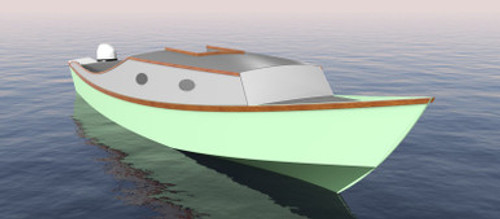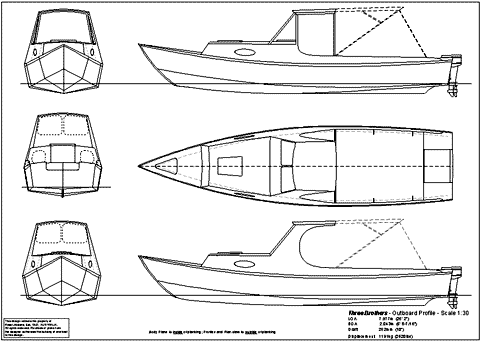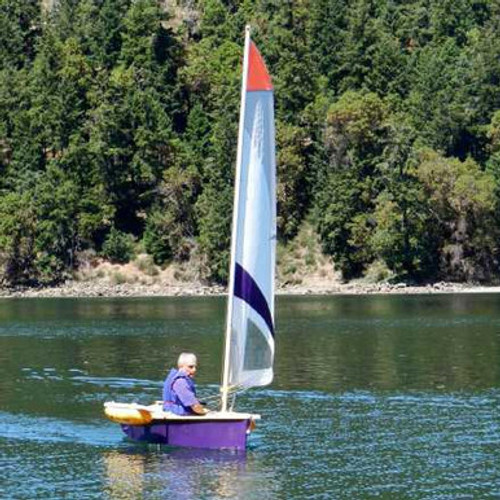Three Brothers
An efficient powerboat for work and play
Some time ago I received a letter from my long-time boating and bush-exploration friend, Ian Hamilton. Ian seemed to have been going through something of an extended mid-life crisis, but never having been one to comply with convention, his mid-life crisis-driven ideas were not much different from his normal fantasies, and I didn't pay him too much attention.
Ian's latest idea was for us (not that I was consulted about the 'us' bit) to wander over to Western Australia to spend a few months exploring the Kimberleys. Australia is a very big place - as big as the U.S. - and most of it is made up of desert. In fact, Australia is the driest inhabited continent on the face of the globe: the Kimberleys are as far from where we live as it is possible to get in this country - about 3,500 kilometers or 2100 miles in a straight line, and all across uninhabited desert...
Now, I am interested in the Kimberleys - the fantastic terrestrial and nautical scenery - but I didn't ever believe that the trip would come off. With that in mind, I let Ian babble on about boats and equipment in the hope that it would all go away. However, he has remained persistent, and for a long time he pushed to have a boat designed which would have the load-carrying ability and the range, to operate in that remote part of the world.
Ian had been using a Phil Bolger-designed Sharpshooter for quite a few years, and I told him she was the boat for the job - 23 feet long by 5 ft 7ins in breadth with a flat bottom, she had proved to be unexpectedly seaworthy and burdensome. The trouble was that Ian wanted just a few more things - like room, comfort, freedom from pounding - and he wanted me to design the boat.
Some time ago I did some preliminary sketching of possible layouts, drawing on experience I had gained with some much smaller rowboats of similar form. My feeling was that the hull-form (similar to William Hand's designs in some respects) had the potential to make a decent semi-displacement cruiser which would operate well with small power plants.
Nothing much happened after that for a long time, due to health and workload issues, and the proposal lay dormant as a profile sketch.
Here is a copy of the text of one of Ian's letters, just to show what he had in mind: -
Dear Rossco.
I've been thinking more about my proposed Kimberley trip & about extended bouts of local & backcountry cruising.
Advantages of Sharpshooter:
- Floats on wet sand
- Is safe in rough water, with ultimate lifeboat capability
- Is fast enough
- Can carry a big load
- Is easy to trailer, launch & retrieve, despite its length
- Is cheap to own & run
- She already exists!
But: She's no joy to windward in a chop & not really comfortable to "live" on for extended periods of foul or very hot weather.
So: Could I drop a load of wishes on you to be considered in a new design which keeps most of the virtues but adds comfort in terms of live-on ability and use in nasty conditions? The compromises I would tolerate? She will obviously be bigger and cost substantially more (while still being smaller, simpler & cheaper than most would consider for the task!)
This boat should be considered a very basic, but comfortable cruiser for two & a dayboat for three or four adults and a bunch of kids.
The accommodation can be "cozy". I'd like to string it out lengthwise to produce a long, narrow, low and light boat that is easy to tow and to power. Sharpshooter runs at 9 or so knots in the rough and about 19knots flat out, fully loaded, on 30hp. This is fine, so if the expanded boat could do that with maybe 50hp I would be very happy. The major difference being... I want to be able to run smoothly in a chop. (You know the sort of water I'm talking about, and 8 to 10 knots in those conditions would be fantastic if sustainable.)
Accommodation:
Main cabin:
- 2 berths.
- galley... 600 x 600 boxes p&s would do... just for a camp stove & bench top... sitting headroom at the galley end... no running water
- cabin / galley bulkheaded off from the fuel
- lockable
Doghouse:
- soft top or hard... maybe 2000 aft from the bulkhead. I wouldn't be thinking to load up the roof on a narrow boat. (At most a small solar panel)
- Standing room at the helm (fold down seat)
- Side seat under the shelter (convert to berth, stowage beneath)
- This area should be open to provide cool shade and enclosable with "clears" in monsoonal rain
- In a gesture toward true luxury, I'd probably build a very light, open-topped, removable enclosure for a porta loo & weed sprayer shower, behind the helm.
Cockpit:
- Good size for fishing / room to lay a couple of camp mattresses for kids /room for a pair of camp chairs & a folding table
- Seaworthy outboard well and motor mounted on the transom, with room for an auxiliary in one of those nice setups like Phoenix 3.
Construction:
- Whether I build it or palm it off, construction should be robust, simple, quick and plywood, with a view to maintenance and repair in isolated locations.
She needs to be able to look after herself in locations with big tides (7m at Broadsound!) hard south-easterlies, unfriendly wildlife, lots of rocks, shoals & reefs and to be trailered very long distances routinely.
Should be pretty easy, really!
Ian
Jumping to now -
Ian rang me a couple of months ago to say that he had seen the advertisement for the WoodenBoat/Professional Boatbuilder Design Competition 2 , and said that he thought that something like the boat we had been discussing would fit the design prescription perfectly. So, I started burning the midnight and early morning oil in an attempt to get a design on paper, and to do the required calculations to determine whether such a boat could meet the criteria specified in the competition rules.
Two-and-a-bit months down the track, and I have a buildable design on paper, with two different wheelhouse layouts, and a completed weight analysis. The conservative weight calculations and the comparative data from the hull drawings have allowed me to make some firm predictions regarding speed, fuel consumption, and load-carrying ability.
In broad terms, the character of the design is as follows:
- Long and narrow with a very fine entry to promote fuel efficiency and smooth running in a short, steep chop;
- Light-weight and simple;
- Hull-form optimised for efficient operation in the semi-displacement speed-range;
- Trailerable.
My performance predictions with 288kg (634lbs) passenger weight and 85kg (187lbs) for engine and fuel are as follows: -
- Assume displacement of 820kg (1804 lbs) NOTE: This is for the performance calculations only. Displacement as shown in the drawings is 1191kg (2620 lbs) so the boat is capable of carrying significantly more than the 288kg (634lb) passenger load.
- Salt water
- LWL 22.6 ft
- Power to achieve 10kts - 13.9hp
- Power to achieve optimum SL ratio 2.2 - 15.6hp
- Speed with 30hp (Crouch's Planing Speed Formula) - 19.3kts
- Speed with 40hp (Crouch's Planing Speed Formula) - 22.3kts
- Speed with 50hp (Crouch's Planing Speed Formula) - 25kts
My choice of motor would be either:
- 18hp four-cycle outboard, giving a full-throttle fuel consumption of approximately 5.7 lt/hr (1.5 gal/hr);
- 30hp four-cycle outboard, giving a full-throttle fuel consumption of approximately 9.8 lt/hr (2.6 gal/hr);
- 30hp two-cycle outboard, giving a full-throttle fuel consumption of approximately 13.0 lt/hr ( 3.4 gal/hr), but with a weight and cost advantage.
Other options include an inboard diesel of between 18 and 22hp, or the Subaru automotive conversion as described in WoodenBoat Magazine #134 and #135. The flat cockpit space would be compromised, but the shape and proportions of the boat make an inboard installation very practical.
Below is a list of some of the elements/intentions/assumptions which under-pin the design:
- Scantlings have been determined by reference to the book of scantling rules titled, "The Elements of Boat Strength" by Dave Gerr. Designed to comply with USLC - Section 5 Sub-section M wherever possible, however it is the responsibility of the builder to ensure compliance with relevant regulations. Scantlings for hull bottom panels and hull topside panels were calculated to comply with the American Bureau of Shipping (ABS) specifications for power boats;
- Plywood construction, using the "stitch-and-glue" method. This allows for fast hull and superstructure assembly without the need for any strongback, mold, or dedicated jig. Quick and economical work for a professional or knowledgeable amateur builder;
- Expanded panel shapes to allow simple marking directly onto the hull panels without the need for patterns or full-sized lofting in a conventional sense. The shapes lend themselves to CNC cutting if desired;
- All bulkheads, frames, and transom are dimensioned to be marked directly onto components without the need for a full-sized lofting;
- The majority of the transverse and longitudinal components do not require bevelling due to the gap-filling characteristics of high-quality marine-grade epoxy and the use of double-bias e-glass reinforcements. Components have been dimensioned with this in mind;
- 22'-wide bunks in cuddy cabin, with good sitting headroom, and storage spaces under and forward of the bunks;
- 7' 4" x 5' 11" self-draining cockpit floor, with provision for shelter from sun and rain. Suitable for camping with as many as wish to squeeze together;
- 6' 3" standing headroom in wheelhouse (6'5" in the centre);
- Cabin sides extend to gunwales in order to maximize volume in cabin, and more importantly, provide a measure of reserve buoyancy in a knockdown;
- Substantial tumblehome in the superstructure to reduce damage when coming alongside wharves etc., to reduce weight and windage aloft, and to ensure that persons standing in the wheelhouse (i.e. high human centres-of-gravity) are pushed towards the centreline. There is a full 4' + at shoulder height, which is plenty for two adults;
- Underfloor stowage available, particularly under the cockpit;
- Built-in foam buoyancy forward and aft;
- Station #1 is designed to meet the scantling requirements of a collision bulkhead;
- Foredeck anchor locker which is self-draining;
- Cabin roof (deckhead) structure designed to comply the requirements for harsh usage, with closely-spaced longitudinal deck beams - but they only intrude ¾" into the cabin space;
- Hull shape optimised for operation in the semi-displacement speed range for reasons of economy, range, and some sort of harmony with the environment;
Attached are my drawings, and the data used in the weight and performance estimates.
Ross Lillistone March 2010
Three Brothers
Cost Estimate
Cost assumptions:
- 18mm marine plywood $51.00 sq.m
- 12mm marine plywood $36.00 sq.m
- 9mm marine plywood $27.00 sq.m
- 6mm marine plywood $16.00 sq.m
- 24mm marine plywood $72.00 sq.m
- Dimensional timber $3000.00 per cu.m
- Epoxy $500.00 per 24lt
- Paint $30.00 per lt
- Fastenings $50 per kg
- Double-bias glass - 400gsm $9.00 sq.m
- Double-bias glass - 330gsm $8.00 sq.m
See attached Weight Estimate Spread-Sheet for cost calculations. Totals as follows: -
- Materials cost ($4228.17)
- Materials cost plus 15% wastage $4862.40
- Engine Allowance $3500.00
Sub-Total $8362.40
Labour estimate between 800 and 1200 hours, so cost based on 1000 hours @ $35.00 per hour, which is my current charge - alter as required to suit local circumstances.
Labour $35,000.00
Grand Total Amateur-built boat $8362.40 (trailer extra)
Grand Total Professionally-built boat $43,362.40 (trailer extra)
Three Brothers plans include 21 sheets of A3 drawings and a 26-page illustrated instruction manual. There are two separate editions of the plans - Imperial and Metric - be sure to choose when you checkout
Ross Lillistone











